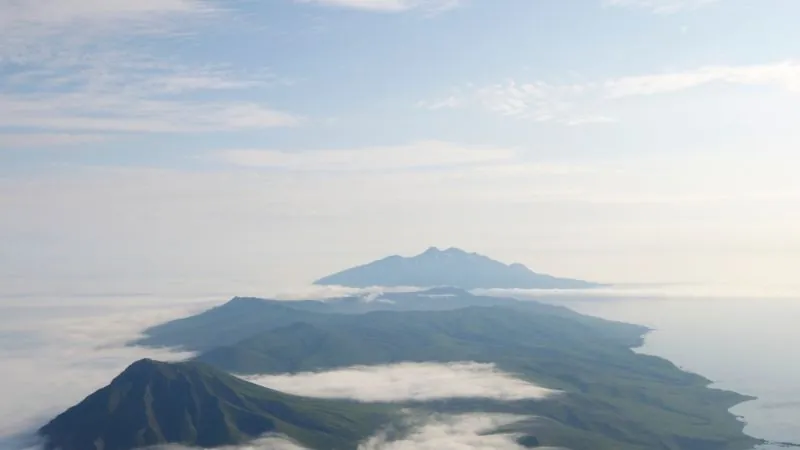
The Identity of the 'Mystery Volcano' That Altered Earth's Climate in 1831 Has Been Uncovered!
2025-01-03
Author: Ling
Discovery of the Mystery Volcano
In an exhilarating revelation, scientists have pinpointed the elusive "mystery volcano" responsible for a catastrophic eruption in 1831, an event that dramatically altered the climate on Earth. Nearly two centuries later, the detective work has paid off, revealing the volcanic source that released an astronomical amount of sulfur dioxide into the atmosphere.
Impact on Climate
The explosive eruption, recognized as one of the most powerful in the 19th century, triggered a significant drop in average temperatures across the Northern Hemisphere, decreasing by around 1 degree Celsius (1.8 degrees Fahrenheit). This event coincided with the tail end of the Little Ice Age, a chilling epoch in our planet's climatic history that lasted for approximately 400 years.
Unraveling the Mystery
While the date of the eruption was well-established, the specific location of the volcano remained a mystery—until recently. Researchers tackled this enigmatic puzzle through analysis of ice cores extracted from Greenland, meticulously examining sulfur isotopes and volcanic ash particles deposited between 1831 and 1834. They employed advanced geochemistry, radiometric dating, and sophisticated computer modeling to trace the trajectories of the volcanic particles.
Link to Zavaritskii Volcano
Their findings culminated in linking the 1831 eruption to Zavaritskii Volcano, located on Simushir Island in the Kuril Islands archipelago, a region embroiled in territorial disputes between Russia and Japan. Prior to this groundbreaking research, the last documented eruption of Zavaritskii was in 800 BC, leading many to dismiss it as a candidate for the monumental 1831 eruption.
Challenges of Isolation
Dr. William Hutchison, the lead author of the study and a principal research fellow at the University of St. Andrews, expressed the challenge posed by the remoteness of Zavaritskii. “The island is isolated, with no permanent inhabitants and limited historical records, primarily from sailors passing through every few years,” he explained.
Revisiting Hypotheses
Initially, researchers considered eruptions closer to the equator, such as the Babuyan Claro volcano in the Philippines, as the likely culprits. However, Dr. Stefan Brönnimann, a climatology expert not involved in the study, highlighted the previous misconception: “For years, this eruption was wrongly associated with a tropical volcano.”
Findings from Ice Core Analysis
The analysis of the Greenland ice cores unveiled an astonishing find—sulfur fallout from the eruption was approximately six and a half times greater in Greenland compared to Antarctica, suggesting that it originated from a significant midlatitude volcano in the Northern Hemisphere.
Chemical Analysis and Eureka Moment
The researchers conducted comprehensive chemical analyses of tiny volcanic glass shards and ash, ultimately leading them to the geochemical signature that matched Zavaritskii. “When I compared samples from the ice core and the ash, it was a genuine eureka moment,” Hutchison noted with excitement.
Radiocarbon Dating Results
Radiocarbon dating placed some ash deposits from Simushir Island within the last 300 years, and further analysis suggested that a massive eruption likely occurred between 1700 and 1900, solidifying Zavaritskii as the prime suspect for the extraordinary event of 1831.
Climatic Context and Changes
This eruption not only marked a significant climatic event but also coincided with the decline of the Little Ice Age—a period characterized by a dramatic drop in temperatures. During this frigid epoch, average annual temperatures in the Northern Hemisphere plummeted by 1.1 degrees Fahrenheit (0.6 degrees Celsius), with some regions witnessing chilling declines of 3.6 degrees Fahrenheit (2 degrees Celsius) over decades.
Other Notable Eruptions
In addition to Zavaritskii, other notable eruptions occurred during this timeframe, including Mount Tambora in Indonesia in 1815 and Nicaragua's Cosegüina in 1835, with the 1808 eruption's source still a mystery. The newly identified Zavaritskii illuminates the significant role that the Kuril Islands play in changing global climates.
Socio-Economic Impacts
The ramifications of the 1831 eruption were dire, as cooler, drier conditions contributed to widespread agricultural failures and famines across regions such as India, Japan, and Europe. Researchers are now exploring the extent to which volcanic-induced climate shifts compounded by socio-political factors led to these widespread hardships.
Need for Global Monitoring
As the study enhances our understanding of 19th-century volcanic activity and climate interactions, scientists stress the importance of monitoring remote volcanoes worldwide. Dr. Hutchison warns, “If history has taught us anything, it’s that eruptions in isolated locations can have catastrophic effects on a global scale, often without warning.”
Call to Action
With the stakes higher than ever, the findings emphasize the need for a coordinated international response to potential future eruptions, prompting an urgent call to action for better preparedness in facing nature's unpredictable power.



 Brasil (PT)
Brasil (PT)
 Canada (EN)
Canada (EN)
 Chile (ES)
Chile (ES)
 Česko (CS)
Česko (CS)
 대한민국 (KO)
대한민국 (KO)
 España (ES)
España (ES)
 France (FR)
France (FR)
 Hong Kong (EN)
Hong Kong (EN)
 Italia (IT)
Italia (IT)
 日本 (JA)
日本 (JA)
 Magyarország (HU)
Magyarország (HU)
 Norge (NO)
Norge (NO)
 Polska (PL)
Polska (PL)
 Schweiz (DE)
Schweiz (DE)
 Singapore (EN)
Singapore (EN)
 Sverige (SV)
Sverige (SV)
 Suomi (FI)
Suomi (FI)
 Türkiye (TR)
Türkiye (TR)
 الإمارات العربية المتحدة (AR)
الإمارات العربية المتحدة (AR)